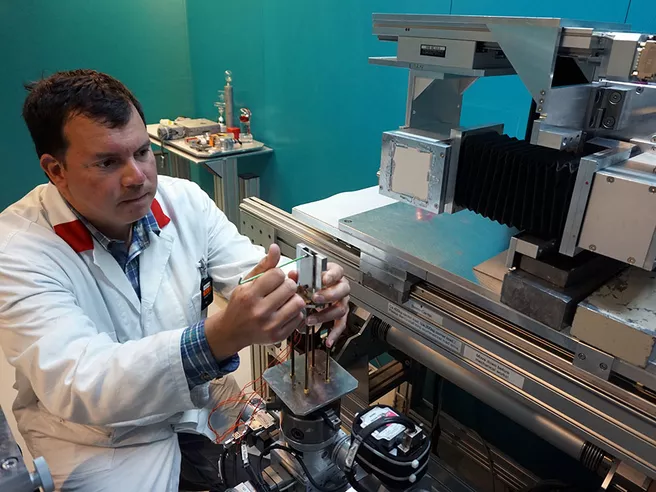Zirconium alloys (Zr-alloys) feature a variety of properties that make them an ideal cladding material for nuclear reactors fuel elements. They are corrosion resistant and highly deformable, show good behaviour in high temperature water, and have a very low neutron absorption. The components of Zr-alloys are, however, susceptible to hydrogen embrittlement which results from the water oxidation of Zr-alloys. When incorporated by the Zr-alloy, hydrogen causes the cladding material to blister and crack, thereby reducing the alloy’s ductility. But what is the exact mechanism underlying this hydrogen embrittlement? And how can Zr-alloys be improved to withstand it? These are the main questions that Dr. Sergio Raul Soria from Argentina seeks to answer during his research project at the MLZ.
Dr. Soria studied physics and engineering sciences at the Instituto Balseiro in Bariloche, Argentina. In his PhD thesis, he was already interested in the different mechanical properties and degradation mechanisms of nuclear materials. Therefore, Dr. Soria was very eager to continue with the project of a former PhD student from the Instituto Balseiro that focused on the changes of Zr-Alloys’ mechanical properties due to hydrogen degradation. He started the project in Argentina in April 2018. For the further realization of the project, however, he wanted to come to the MLZ in Garching. For this, he was granted the renowned Georg Forster Research Fellowship of the Humboldt foundation, which is only awarded to non-German researchers with excellent scientific qualifications.
Since September 2018, Dr. Soria has investigated the redistribution of hydrogen in Zr-Alloys under concentration, temperature, and stress gradients. To detect the hydrogen atoms in the samples, he uses the neutron imaging facility ANTARES at the Research Neutron Source Heinz Maier-Leibnitz (FRM II). The measurements with ANTARES’ cold neutron beam feature a high penetration of metals as well as high sensitivity to hydrogen, and thus, provide ideal conditions for Dr. Soria’s experiments. “With ANTARES, I hope to clarify the degradation mechanism underlying the hydrogen embrittlement of Zirconium alloys. This way, we could improve the cladding material for fuel elements in the future.”
For Dr. Soria, working with ANTARES, one of the best facilities of its kind in the world, not only serves to answer his current research question, but also fulfils an educational purpose. In his home country, Argentina, the National Atomic Energy Commission (CNEA) is currently constructing a new multipurpose research reactor, the RA-10. “One of the instruments at the new reactor in Argentina will be very similar to ANTARES”, explains Dr. Soria, “So, learning techniques here at ANTARES will qualify me to handle the instrument at the RA-10.”
Apart from financial support, individual mentoring, and intensive German courses, the Georg Forster Research Fellowship provides the opportunity to return to Germany for further research once the original research stay has come to an end. “I am really enjoying my first time here in Europe. I like the German hospitality, the Bavarian landscape, and the beer!", says Dr. Soria with a smirk on his lips, "I am looking forward to coming back to MLZ for another exciting neutron project!” For the MLZ, it is a pleasure to host scientists like Dr. Soria and provide cutting-edge research instruments for researchers from all over the world.
